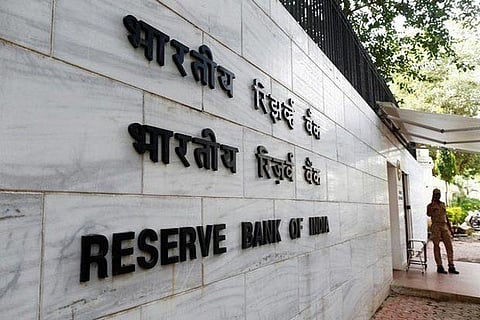

New Delhi
The RBI committee said that UCBs can be split into four categories -- Tier-1 with deposits up to Rs 100 crore; Tier-2 with deposits between Rs 100-Rs 1,000 crore, Tier-3 with deposits between Rs 1,000 crore to Rs 10,000 and Tier-4 with deposits of over Rs 10,000 crore.
It has suggested that the minimum Capital to Risk-Weighted Assets Ratio (CRAR) for them could vary from 9 per cent to 15 per cent and for Tier-4 UCBs the Basel III prescribed norms.
The RBI panel has also prescribed separate ceilings for home loans, loan against gold ornaments and unsecured loans for different categories of UCBs.
In February, the RBI had the constitution of the Expert Committee on Primary (Urban) Co-operative Banks under the chairmanship of N S Vishwanathan, former RBI Deputy Governor.
On consolidation of UCBs, the panel in reports said that RBI should be largely neutral to voluntary consolidation except where it is suggested as a supervisory action.
"However, the RBI should not hesitate to use the route of mandatory merger to resolve UCBs that do not meet the prudential requirements after giving them an opportunity to come up with voluntary solutions," it said.
The minimum capital stipulation provides an embedded size to a UCB.
It''s recommendations on resolution of UCBs, the committee said that under the Banking Regulation (BR) Act, the RBI can prepare scheme of compulsory amalgamation or reconstruction of UCBs, like banking companies.
This may be resorted to when the required voluntary actions are not forthcoming or leading to desired results.
The panel further said Supervisory Action Framework (SAF) should follow a twin-indicator approach -- it should consider only asset quality and capital measured through NNPA and CRAR -- instead of triple indicators at present. The objective of the SAF should be to find a time-bound remedy to the financial stress of a bank.
If a UCB remains under more stringent stages of SAF for a prolonged period, it may have an adverse effect on its operations and may further erode its financial position, it said.
It further suggested that amendments to the BR Act empowering the RBI to declare certain securities issued by UCBs as covered under the Securities Contract Regulation Act to facilitate their listing and trading in a recognised stock exchange may be made.
Till such time, the RBI may consider allowing banks in Tier 3 and 4, having the necessary technology and wherewithal, to issue shares at premium to persons residing in their areas of operation subject to certain conditions, the panel said.
Owing to lack of the desired level of regulatory comfort on account of the structural issues including ''capital’ and the gaps in the statutory framework, the regulatory policies for co-operative banks have been restrictive with regard to their business operations, which, to some extent, has been one of the reasons affecting their growth.
With the enactment of the Banking Regulation (Amendment) Act, 2020, the statutory gaps have been addressed to a very large extent.
As per the report, the committee noted that the UCB sector has been under stress for quite some time.
It felt that given the importance of the sector in furthering financial inclusion and considering the large number of its customer base, "it is imperative that the strategies adopted for the regulation of the sector are comprehensively reviewed so as to enhance its resilience and provide an enabling environment for its sustainable and stable growth in the medium term".
In the committee’s view, while it was possible that the structural factors arising from the cooperative character underlying the UCBs could still pose some challenges, the amendments to the BR Act address to a large extent the gaps in the legislative framework.
The panel suggested that that the recent amendments to the BR Act need to be supplemented by legislative enablement for listing of certain securities issued by the UCBs.
On housing loans, the panel said the maximum limit on housing loans may be prescribed as a percentage of Tier 1 capital, subject to RBI-prescribed monetary ceiling for Tier 1 UCBs (but higher than the present ceiling) and respective board of directors-approved ceiling for Tier 2 UCBs.
For Tier 2 UCBs, the risk weight on housing loans may be prescribed based on size of the loan and loan-to-value (LTV) ratio, in line with SCBs.
The panel has also made recommendations regarding loan against gold ornaments with bullet repayment option.
It also said that umbrella organisation (UO) is expected to play a crucial role in the strengthening of the sector.
For that, it must be a financially strong organisation with adequate capital and a viable business plan. The minimum capital for the UO should be Rs 300 crore with CRAR and regulatory framework akin to the largest segment of NBFCs, the panel said.
Alos, in the long run, the UO may take up the role of a Self-Regulatory Organisation (SRO) for smaller UCBs.
The report said there were two broad sources of constraints because of which the sector has underperformed.
The first set of factors are internal to the sector. Many UCBs are small and do not have either the capability - financial or human resources – and/or possibly inclination to provide technology enabled financial services.
The second set of constraints are external to the banks. These emanate from the rather restrictive regulatory environment under which they have had to operate.
There were suggestions that licensing of new UCBs should be immediately opened up. There are over 1,500 UCBs already. The committee has suggested that the existing UCBs may be allowed to expand their footprint.
The number of borrowers of UCBs is estimated at 67 lakh.
Visit news.dtnext.in to explore our interactive epaper!
Download the DT Next app for more exciting features!
Click here for iOS
Click here for Android